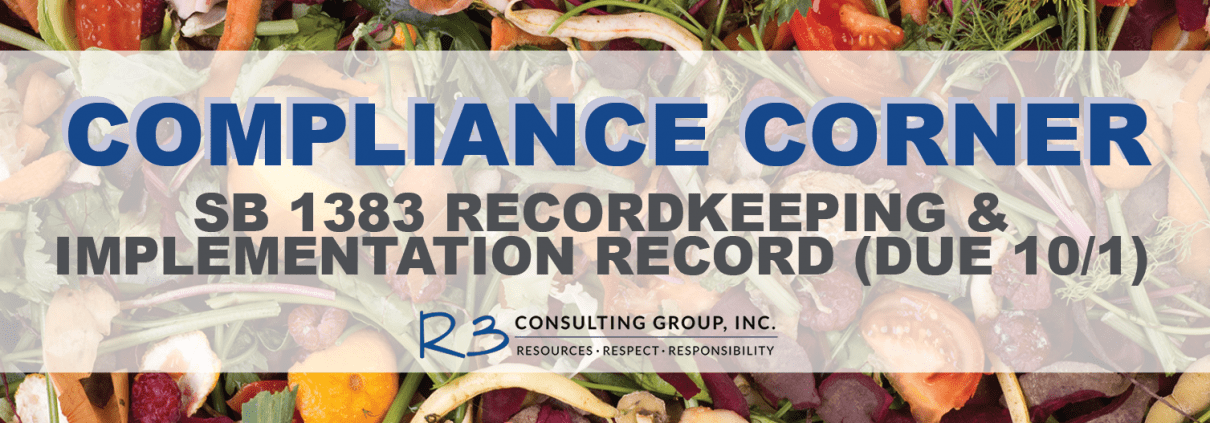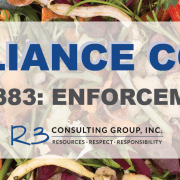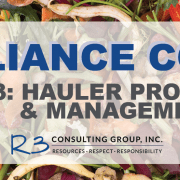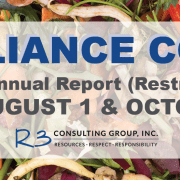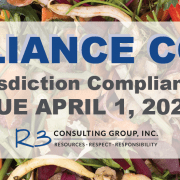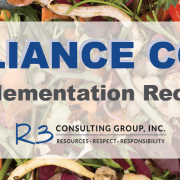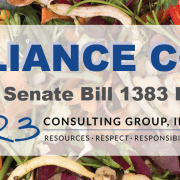Compliance Corner – September 2022
Recordkeeping / Implementation Record (Due 10/1!)
This month, we are clarifying the differences between the regular CalRecycle reporting and the Implementation Record, which is a new requirement introduced by SB 1383. Many of our clients don’t initially realize that they’re actually different requirements, and with the Electronic Annual Report (EAR) this year including so many new questions, the Implementation Record may fall to the wayside.
Recordkeeping requirements for SB 1383 can be complex, particularly the implementation record and the restructured EAR. The EAR is due to CalRecycle by October 1st of this year, which means it’s creeping up fast! Next year and the years following, the EAR will be due August 1st.
An implementation record must be kept by all jurisdictions as a recordkeeping system, with the required documentation for SB 1383, stored for at least 5 years. Additionally, the implementation record can be used to help jurisdictions complete their EAR and offers an easy place to store supporting documentation which may be requested by CalRecycle at any time.
Implementation Record
Each jurisdiction should maintain all records required by SB 1383 using an Implementation Record, such as the Model Implementation Record Tool provided by CalRecycle. Some cloud-based software solutions also incorporate the Implementation Record, which needs to be entered by the City and hauler into the software.
The Implementation Record must include the following information:
- Ordinances and enforceable mechanisms, which means your SB 1383 ordinance as well as the adopting ordinances for the Model Water Efficient Landscaping Ordinance and CALGreen (or another code chapter if you have one dedicated to Construction and Demolition debris recycling).
- Written program descriptions, which means a few paragraphs describing your hauling contract(s) as well as regular activities on the City/County side.
- Organic waste service collection method, which is whether you use the 3-container system (garbage, recycling, and organics including food scraps), or another collection system that includes back-end processing to remove organics before landfilling.
- Contamination minimization, including route reviews and waste evaluations.
- Waivers and exemptions on file.
- Education and outreach completed that year (for the October 1 report, this is only for the first 6 months of 2022).
- Jurisdiction oversight of hauler programs, including franchise agreements, types of hauler system(s) used, conditions for approvals/denials/revocations, and copies of all required reports.
- Edible food recovery, such as education and outreach, monitoring compliance, increasing capacity, funding mechanisms, a list of Tier 1 and Tier 2 edible food generators, and a list of food recovery organizations and services and their capacity for recovery.
- Recovered organic waste product procurement, including purchases of qualifying products, written contracts or agreements with direct service providers, and the jurisdiction’s efforts to identify additional procurement opportunities.
- Paper procurement, such as copies of invoices, receipts, or other proof of purchase that describe procurement of paper products by volume and type, and percentage of post-consumer waste recycled content for all paper purchases (or explanation of why minimum 30% recycled content paper was not purchased).
- Inspection and enforcement activities, which means notes from phone calls and/or site visits, photos, and any other applicable documentation.
- Compliance reviews, which means the desktop review of customer compliance with the requirement to subscribe to recycling and organics service.
- Investigation of complaints and alleged violations.
Restructured EAR
Each jurisdiction is required to submit an annual report to CalRecycle demonstrating implementation of applicable state laws, including AB 939, AB 341, AB 1826, and, of course, SB 1383. In 2022, each jurisdiction must submit a restructured report including its compliance with the requirements of SB 1383 by October 1, 2022, covering information from January 1, 2022 through June 30, 2022. The report should cover the dates of January 1, 2022 to June 30, 2022 for SB 1383 requirements newly enacted. Starting in 2023, submittal of the EAR will be required by August 1 and will cover the previous calendar year. The required information for the EAR is outlined below, in the order of the restructured EAR on the Local Government Information Center (LoGIC) online portal.
The good news is that while the new report can be a bit confusing, CalRecycle Local Market Assistance and Development staff has made themselves very available to answer questions, and CalRecycle has also offered a number of webinars, including one next week to answer last-minute questions.
The annual report must include the following information as it relates to the implementation of the following:
- Procurement
- Amount of each recovered organic waste product (ROWP) procured directly by the city, county, or through direct service providers (or both) during the previous calendar year
- If implementing procurement requirements through an adjusted ROWP procurement target, report the total amount of transportation fuel, electricity, and gas for heating applications procured during the previous calendar year
- Each type of recycled product procurement
- SRRE procurement programs description
- Edible Food Recovery
- Number of commercial edible food generators within the jurisdiction
- Number of food recover services and organizations located and operating within the jurisdiction, that contract with or have written agreements with commercial food generators
- Total pounds of edible food recovered in the previous calendar year (services/organizations must report amount to the jurisdiction)
- Collection Systems
- Type of collection services provided to residential and commercial generators
- Number of generators that receive each type of service
- If applicable, RDRS number of high diversion organic waste processing facilities
- If applicable, facility that accepts compostable plastics
- If applicable, facility that accepts and removes organic waste in plastic bags
- Number of haulers approved (or denied) to collect organic waste in the jurisdiction
- Commercial and Residential Programs
- Material types collected
- SRRE commercial and residential programs description
- Large venues and events
- Education and Outreach
- Number of generators that received information and the type of education and outreach used for SLCP, MCR, MORe, and SRRE/HHWE
- Number of commercial generators that received information and the type of education and outreach used for edible food recovery
- SRRE education and outreach programs description
- Model Water Efficient Landscape Ordinance (MWELO), CALGreen Building Standards and C&D
- Number of C&D debris removal activities conducted in compliance with CALGreen
- C&D material types collected
- SRRE programs description
- Hazardous Waste Programs
- SRRE hazardous waste programs
- Disposal Rate Calculation
- Disposal tons for reporting year
- If applicable, disposal reduction credits
- Calculation factors, including disposal rate accuracy, alternative disposal tonnage, deductions to RDRS disposal tonnage, and/or green material alternative daily cover (ADC)
- Waivers and Exemptions
- Number of generators waived from requirement to subscribe to an organic waste collection service
- Number of days emergency circumstances waiver was in effect and type of waiver issued
- Tons of organic waste disposed as a result of emergency waivers
- Number of generators issued a de minimis waiver
- Number of generators issued a physical space waiver
- Number of commercial generators exemptions under MORe and rationale
- Jurisdictions that receive a waiver from CalRecycle shall report, for each year the waiver is in effect, the number of generators waived from the requirement to subscribe to organic waste collection service
- Contamination Monitoring, Inspections, and Complaints
- Number of route reviews
- Number of times notices, violations, or targeted educational materials were issued to generators
- Results of waste evaluations performed and number of resulting target route reviews
- Numbers of inspections conducted (commercial businesses, and edible food recovery for Tier 1 & Tier 2 generators, food recovery organizations & services)
- Numbers of complaints received and investigated
- Enforcement and Monitoring
- Numbers of generators included in compliance reviews for SLCP (SB 1383), MORe (AB 1826), and MCR (AB 341)
- Number of route reviews conducted (or waste evaluations performed) annually for commercial businesses and residential generators
- Number of inspections conducted by type for commercial edible food generators, food recovery organizations, and commercial businesses
- Number of NOVs issued, categorized by type of entity
- Number of penalty orders issued, categorized by type of entity
- Number of enforcement actions resolved, categorized by type of entity
- Facilities
- SRRE programs description
- AB 876
- Any changes related to AB 876
- SB 1383 Enforceable Mechanism Changes
- Ordinance changes and documentation
- Types of ordinances
- Primary and Official Contact changes for jurisdiction
- SRRE programs description
- Planning Documents Assessment
- Rural petition for reduction in requirements
- SRRE
- Household Hazardous Waste Element (HHWE)
- Non-Disposal Facility Element (NDFE)
- Areas of concern and conditional approvals
- Additional Information and Document Management
- SRRE and HHWE diversion program management
- Additional Information
In addition, Counties shall report the following regarding implementation of organic waste recycling capacity planning and edible food recovery planning:
- Tons estimated to be generated for landfill disposal
- Amount of capacity verifiably available to the county and cities
- Amount of new capacity needed
- Locations identified for new or expanded facilities
- Jurisdictions that are required to submit implementation schedules
- Jurisdictions that did not provide information required to the county within 120 days
Helpful Links
- Restructured EAR Jurisdiction Tool
- Organic Waste Recycling Capacity Planning Calculator
- Edible Food Recovery Capacity Planning Calculator
- Model Implementation Record Tool
- Model Performance Implementation Record Tool
- Implementation Record Webinar Recording
- Implementation Record PowerPoint

